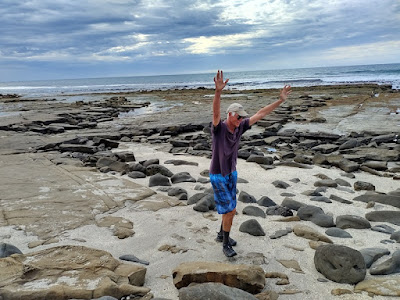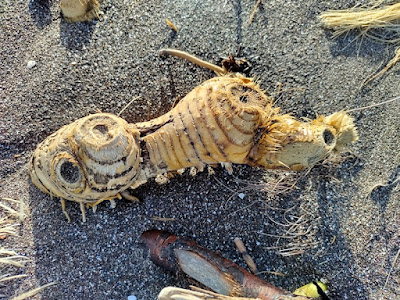We search out remote, isolated places to park overnight whenever we can. We found a beach at the end of a road that wound around the end of a little-used airport runway. These shells were scattered in piles around the site.
Punta Abreojos (Lookout Point) was at the end of a long road across the Baja. We met another van lifer there, Mike, along with his dog, Biscuit. Biscuit loves to dig and chase and chew rocks and shells. Here, he dug a hole behind YOLO and we had to fill it in to back out to leave a day or two later.Sunsets on the Baja are magical.
Jason and Mike solving the problems of the world while waiting for dinner to be served.
Jason and Mike`s red van in the dunes at Pta. Abreojos. We could drive on the hard packed sand but not beyond the dunes where the sand got soft and deep. This area got hit by Hurricane Kay in Sept, 2022 and we could see the evidence of the water that must`ve surged over the dunes here. A lot of damage was done.
Jason, Mike and Biscuit. We drove to the next town up the beach so Mike could show us evidence of the "boring clams" he was certain were the cause of the holes in the rocks on the beaches near here. I thought gas bubbles might have been the cause of the holes in the basalt, but he eventually convinced me that piddock/razor clams created the holes. I`m now a convert.We parked at the port just as the local lobster fishermen came in from their fishing run. They collected tons of sardines that they use for bait in the lobster traps. The lobster industry here is a collective effort and they are doing very well, flush with cash right now. All the lobster are sent to China while still alive.
The launches came in loaded to the gunwales with sardines. We wondered how long this practice could be sustainable.
We left the port and motored on over the hill to the rocky beach where Mike had found some unusual rocks. Jason and Mike clamber over some flat slabs at low tide.
An example of the holes in the rocks caused by a particular type of clam that bores perfectly round holes in the rocks. The raspy shells grind the holes as the muscles in the clams twist deeper into the rock for protection.
Jason calling for a truce between Mike and me about our different theories before I became a convert to Mike`s explanation for the holey rocks.
Weird stuff in the cracks of these rocks, too. Some unusual geology happened around here once upon a time. The stripes look like tar, but it is another form of rock I can not explain.
Some of the rock with holes that still contain the remains of the clams that bored them.
More weird formations in the rocks on the beach. Concretions of something have been embedded into the rock and are now worn smooth by the waves.
A bunch of locals were hunting for something on the rocky ledges during the low tide and we found this man with a bucket of what he called "las cucarachas de mer". They are a chiton that the locals hunt and pry off the rocks during low tide. They claim they are like candy bait for the lobsters. Octopus also hide in the rocks along the beach here and he had a couple in a plastic bag to take home to eat.
A local couple stopped by to feed some homeless dogs at a nearby non-descript building. They told us it was an abalone farm and we should ask to see it/take a tour if we were still here the next day. We asked at the door and a young lady was excited to practice her English giving us a tour of the facility. Layers of metal are set into fiberglass tanks and the abalone cling to the metal underneath. They love the dark, hate the light.
These are rare baby blue abalones, found only here on Baja. They raise them for 4 years and then ship them live to China as a delicacy. They get shipped with all those live lobsters, I suppose.
The lady manager was showing us how to tell the gender of an abalone by peeling back their tentacles along one edge. She knows her stuff about abalones.
An adult blue abalone, good for breeding. Pretty, eh?
They had a couple of tanks with a few lobsters, too, that they held for the local restaurants who offer live lobster on their menu. She told us lobsters will eat anything.
Such a boring looking building on a cliff in a tiny town of La Bocana in Baja, this is the abalone farm. They must irrigate the tanks inside with seawater and keep them oxygenated or the shellfish will die. They harvest kelp from just offshore to feed the abalone.
More unusual rock formations along the shore here at La Bocana.
Unusual patterns in the sands along the beach.
Black and white designs by Mother Nature in the sand.
A big, heavy sand dollar and a tiny delicate white spiral shell were some of my finds at the beach just north of Punta Abreojos on Baja.
Natural colors in a lobster tail found on the beach there.
This is a ray `s purse, an egg sac for a stingray. It was washed up on the beach here, too.
A colorful collection from a single walk on the beach by Punta Abreojos.
On many beaches and roads in Mexico, we`ve found piles and piles of shells like this one. Each pile seems to be of the same type of shell, but each pile may be a different type. These are Venus clams, a pretty shell with V-shaped markings.
A pretty orange shell stands out in this pile.
Some cool blood red jasper rock next to a rock with those holes from the boring clams.
Another shell collection. There are so many shells here I could not believe it.
Sunset from our camp site north of Punta Abreojos.
YOLO under some pretty clouds along the beach.
Karen relaxing looking out the back door of YOLO at our beach scenery.
A whale skeleton along the roadside.
Skeletons and carcasses along the beach were quite common. I am not sure what this snake-like spinal skeleton is from.
A small hammerhead shark head chopped off and washed up on the shore.
The other side of the hammerhead shark head reminds me of Yoda or those space creatures in the bar of one of the movies. Fishermen cut off the heads and toss them overboard and they wash ashore.
A stingray carcass on shore.
A starfish, too, on the shore, dead. It can be quite interesting to walk a beach here. You never know what you might find.
Shells are still a good find along these beaches. Pretty and colorful. The green rocks are volcanic tuff, I think. Lots of color.
A hazy celestial body over the beach.
Palmetto fronds set out to dry. They will be used to make Christmas decorations in some village or town.
Such colorful sunsets. I just don`t get tired of them.
Horses along the road near Mulege.
Vultures on posts of a wrecked building. Lots of these big black birds were around.
A Mexican cowboy on the beach. He took tourists for rides along the beaches near Mulege.
I finally broke out the hammock near Mulege, but the wind made it too cool to spend much time in it. There are few places to anchor the ends of a hammock on a beach or in a desert. Not many trees.
A weird piece of wood washed up on the beach. It is the remains of some weedy shrub that looked sort of like a seahorse to me.
I like these little translucent shells I find. And the spiral with all its spikes is unusual. They don`t often survive the tumble in the waves and sand.
This colorful clam just sat up on the sand so I took a picture of it before it was broken apart and crushed with time and waves or footsteps.
So many pretty findings on a beach.
And in the sky. Love those coral colored tendrils reaching out of the cloud.
A semi truck carrying crates of asparagus crashed and burned to a hulk on a tight curve on a hill. Traffic was stopped to let a tow truck crane move the burned out ruin out of the way.
This is the kind of rutted road we may have to traverse to reach a camp site. Beyond this, it flattens out and we had the entire place to ourselves.
Jason hooking up the electrical cord at the beachside camp spot we found. All these places are free, too!
Clear water on the shore of this rocky beach. The clarity of the waters here surprised me, what with all the trash we see on the land.
Dolphins were swimming just offshore from where we camped.
Sunset on the far side of the Bay of Conception turned these mountains a pretty color.
One day we hung the blue bug curtain so we could keep the insects out and let the air in. We had little issues with bugs on Baja overall, though.
A heron on the shore, stalking for a fish.
The road at the end of the Malecon (beachside road) in Loreto. The parking here was full but we did stay on the road overnight here.
Colorful big letters along the Loreto malecon.
Karen with a statue of sea lions at the marina in Loreto.
A statue of Don Quixote at a fancy hotel in Loreto
The tunnel Jason is walking next to is only for short people, I guess.
Doesn`t this look like it belongs in a Western movie set?
The old Mission of Our Lady of Loreto dated back sevral hundred years.
The inside of the mission church, getting decked out for Christmas.
The gilded alter in the church.
A very old painting of Michael the Archangel on the wall. The church is still used for services, too.
A metal marriachi band on the roof of a local bar in Loreto.
The beautiful blue of the Bay of Conception.
This statue and the letters again a the viewpoint along the road.
Beyond the waters are these sharp mountains, another pretty backdrop any day.
The local electric company putting up a support pole for birds to nest on. They put them higher than the tops of the telephone poles in hopes that the birds will build their nests on them instead of on the telephone poles. What a nice idea.













































.jpg)

.jpg)



.jpg)


.jpg)

















.jpg)
.jpg)




No comments:
Post a Comment